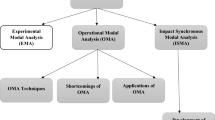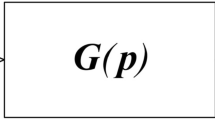Abstract
Following the widespread implementation of Phasor Measurement Units (PMU) across the power grid, the measurement-based methods are extensively used to track power system oscillations efficiently in real-time. This paper proposes a novel dynamic approach for rapid monitoring and identification of electromechanical oscillation modes using real-time measurement signals. The measurement-based method has been recently improved by the Variational Mode Decomposition (VMD) technique, a nonlinear, nonstationary analysis tool used to estimate low-frequency modes in the power system. However, the random selection of the initial parameter utilized in the conventional VMD process significantly affects its performance and often leads to computational complexities. Thus, a Modified Variational Mode Decomposition (MVMD) method based on Particle Swarm Optimization (PSO) has been proposed in this work. MVMD eliminates unnecessary decomposition modes involved in the conventional VMD process by optimizing parameters using PSO. The analysis of these modes is accomplished by assessing instantaneous modal parameters using the Hilbert transform and spectral analysis. The raised approach is validated using a test signal, IEEE standard 16 machine 68 bus system and real-world PMU data. Simulation results show that the dominant low-frequency oscillatory mode with high noise tolerance can be effectively determined with less computational complexity.



















Similar content being viewed by others
References
Graham R.: Power System Oscillations. Springer US (2000)
Gautam, D.; Vittal, V.; Harbour, T.: Impact of increased penetration of DFIG based wind turbine generators on transient and small signal stability of power systems. IEEE Trans. Power Syst. 24(3), 1426- 1434 (2009). https://doi.org/10.1109/TPWRS.2009.2021234
Kundur P.: Power system stability and control. Twelfth reprint. New Delhi, India, Tata McGraw-Hill Education Pvt. Ltd, 2011
Shigenori, O.; Hiroshi, S.; Katsuhiko, U.: Modal analysis for power system dynamic stability. IEEE Trans. Power Apparat. Syst. 97(4), 1313 - 1318 (1978). https://doi.org/10.1109/TPAS.1978.354616
Hauer, C.J.; Demeure, L.; Scharf, L.: Initial results in prony analysis of power system response signals. IEEE Trans. Power Syst.5,(1), 80–87 (1990)
Shim, K.S.; Nam, H.K.; Lim, Y.C.: Use of prony analysis to extract sync information of low frequency oscillation from measured data," Euro. Trans. Electr. Power,21, 1746–1762 (2011). doi:https://doi.org/10.1002/etep.531
Guoping, L.; Jaime, Q.; Venkatasubramanian, V.M.: Oscillation monitoring system based on wide area synchrophasors in power systems. IREP Symposium- Bulk Power System Dynamics and Control - VII, Revitalizing Operational Reliability, Charleston, SC, USA (2007)
Anas, A.; Lingling, F.; Zhixin, Miao.: A tutorial on data-driven eigenvalue identification: prony analysis, matrix pencil and Eigen system realization algorithm. Int. Trans. Electr. Energ. Syst.,30 (2020) https://doi.org/10.1002/2050-7038.12283
Sarkar, T.K.; Pereira, O.: Using the matrix pencil method to estimate the parameters of a sum of complex exponentials. IEEE Antennas and Propagation Magazine,37, 48–55 (1995). https://doi.org/10.1109/74.370583
Smith, J.R.; Fatehi, F.; Woods, C.S.; Hauer, J.F.; Trudnowski, D.J.: Transfer function identification in power system applications. IEEE Trans. Power Syst. 8(3), 1282–1290 (1993). https://doi.org/10.1109/59.260866
Zhou, N.; Dosiek, L.; Trudnowski, D.; Pierre, J.W.: Electromechanical mode shape estimation based on transfer function identification using PMU measurements. Proc., IEEE PES General Meeting, Calgary, AB, Canada, 1–7 (2009). https://doi.org/10.1109/PES.2009.5275924
Hamed, K.; Zhang, L.; Venkatasubramanian, V.: Fast frequency-domain decomposition for ambient oscillation monitoring. IEEE Trans. Power Delivery. 30(3), (2015). https://doi.org/10.1109/TPWRD.2015.2394403
Zhang, P.; Yang, D.Y.; Chan, K.W.; Cai, G.W.: Adaptive wide-area damping control scheme with stochastic subspace identification and signal time delay compensation. IET Gener. Transm. Distrib. 6(9), 844–852 (2012). https://doi.org/10.1049/iet-gtd.2011.0680
Nezam Sarmadi, S.A.; Venkatasubramanian, V.: Electromechanical mode estimation using recursive adaptive stochastic subspace identification. IEEE Trans. Power Syst. 29(1), 349–358 (2014). https://doi.org/10.1109/TPWRS.2013.2281004
Jiang, T.Y.; Jia.: Stochastic subspace identification-based approach for tracking inter-area oscillatory modes in bulk power system utilizing synchrophasor measurements. IET Gener. Transm. Distrib. 9(15), 2409–2418 (2015). https://doi.org/10.1049/iet-gtd.2015.0184
Philip, J.G.; Trapti, J.: An improved stochastic subspace identification based estimation of low frequency modes in power system using synchrophasors. Electric. Power and Energy Syst. 109, 495–503 (2019). https://doi.org/10.1016/j.ijepes.2019.01.030
Luke D.; Ning, Z.; Pierre, J.W.; Zhenyu, H.; Trudnowski, D.J.: Mode shape estimation algorithms under ambient conditions: a comparative review. IEEE Trans. Power Syst. 28(2), 779–787 (2013). https://doi.org/10.1109/TPWRS.2012.2210570
Wu, Q.H.; Zhang, A.Q.; Zhang, L.L.; Li, M.S.: Identification of dominant low-frequency oscillation modes based on blind source separation. IEEE Trans. Power Syst. 32(6), 4774 – 4782 (2017). https://doi.org/10.1109/TPWRS.2017.2685533
Messina, A.R.: Inter-area oscillations in power systems: a nonlinear and nonstationary perspective. Springer (2009)
Prince, A.; Senroy, N.B.: Targeted approach to apply masking signal-based empirical mode decomposition for mode identification from dynamic power system wide area measurement signal data. IET Gener. Transm. Distrib. 5(10), 1025–1032 (2011). https://doi.org/10.1049/iet-gtd.2011.0057
Laila, D.S.; Messina, A.; Pal, B.C.: A refined Hilbert–Huang transform with applications to inter-area oscillation monitoring. IEEE Trans. Power Syst. 24(2), 610–619 (2009). doi:https://doi.org/10.1109/TPWRS.2009.2016478
Messina, A.R.; Vittal, V.: Nonlinear, non-stationary analysis of interarea oscillations via Hilbert spectral analysis. IEEE Trans. Power Syst. 21, (3), 1234–1241 (2006). https://doi.org/10.1109/TPWRS.2006.876656
Sanchez Gasca, J.; Trudnowski, D.: Identification of electromechanical modes in power system. IEEE task force on identification of electromechanical modes of the power system, stability, power & energy society, Tech. Report (2012)
Colominas, M.A.; Schlotthauer, G.T.: Improved complete ensemble EMD: a suitable tool for biomedical signal processing. Biomed. Signal Proc. Control, 14, 19–29 (2014). https://doi.org/10.1016/j.bspc.2014.06.009
Rahul, S.; Koshy, S.; Sunitha, R.: Electromechanical mode estimation in power system using a novel nonstationary approach. In: Haes Alhelou H., Abdelaziz A.Y., Siano P. (eds) Wide Area Power Systems Stability, Protection, and Security. Power Systems. Springer, Cham (2020)
Tao, J.; Siyi, L.; Rodolfo, C.C.F.; Wencong, S.: A method for the identification of low frequency oscillation modes in power systems subjected to noise. Appl. Energy, 206, 1379–1392 (2017). https://doi.org/10.1016/j.apenergy.2017.09.123
Shir. F.; Mohammadi ivatloo B.: Identification of inter-area oscillations using wavelet transform and phasor measurement unit data," Int. Trans. Electr. Energy Syst. 25(11), 2831–2846 (2015). https://doi.org/10.1002/etep.1994
Dragomiretskiy, K.; Zosso, D.: Variational mode decomposition. IEEE Trans. Signal Process.62(3), 531–544 (2014). doi: https://doi.org/10.1109/TSP.2013.2288675
Manas, K.J.; Subhransu, R.S.; Bijaya, K.P.: Variational mode decomposition-based power system disturbance assessment to enhance WA situational awareness and post-mortem analysis. IET Gener. Transm. Distrib. 11(13), 3287–3298 (2017). doi: https://doi.org/10.1049/iet-gtd.2016.1827
Mario, R.A.P.; Rajesh, K.T.; Alejandro, Z-M.; Daniel, D.: Identification of electromechanical oscillatory modes based on variational mode decomposition. Electric. Power Syst. Res. 167, 71–85 (2019). https://doi.org/10.1016/j.epsr.2018.10.014
Huaishuo, X.; Jianchun, W.; Hongshun, L.; Qingquan L, Yalin S.: Identification method for power system low-frequency oscillations based on improved VMD and Teager–Kaiser energy operator. IET Gener. Transm. Distrib.11(16), 4096 – 4103 (2017). doi: https://doi.org/10.1049/iet-gtd.2017.0577
Canyi, L.; Shuicheng, Y.; Zhouchen, L.: A unified alternating direction method of multipliers by majorization minimization. IEEE Trans. Patt. Anal. Mach. Intel.40 (3), 527–541 (2017). doi: https://doi.org/10.1109/TPAMI.2017.2689021
Dongmei, W.; Lijuan, Z.; Jikang, Y.; Jingyi, L.; Dingwe, L.; Gongfa, L.: Application of variational mode decomposition based on particle swarm optimization in pipeline leak detection. Eng. Res. Exp. 2 045036 (2020)
Yamille, del V.; Ganesh, K.V.; Salman, M.; Jean-Carlos, H.; Ronald, G.H.: Particle swarm optimization: basic concepts, variants, and applications in power systems. IEEE Trans. Evolutionary Comput.12(2), 171–195 (2008). doi: https://doi.org/10.1109/TEVC.2007.896686
Moshen, K.; Gang, C.; Yusong P.; Yong, L.: Research of planetary gear fault diagnosis based on permutation entropy of CEEMDAN and ANFIS. Sensors 18(782), 1–17 (2018). doi:https://doi.org/10.3390/s18030782
Lauria, D.; Pisani, C.: On Hilbert transform methods for low-frequency oscillations detection. IET Gener. Transm. Distrib. 8(6), 1061–1074 (2014). doi:https://doi.org/10.1049/iet-gtd.2013.0545
Luigi, V.; Sebastian, B.; Jan, O. G.: Preprocessing synchronized phasor measurement data for spectral analysis of electromechanical oscillations in the Nordic Grid. Int. Trans. Electr. Energ. Syst.2, 348–358 (2015). doi:https://doi.org/10.1002/etep.1847
Petre, S.; Randolph, M.: Spectral Analysis of Signals. Prentice Hall, Inc. Upper Saddle River, New Jersey 07458 (2005)
Lalit, K.; Nand, K.: Wide area monitoring of sustained oscillations using double‐stage mode decomposition. Int.Trans. Electr. Energ. Syst.2 (2018). doi:https://doi.org/10.1002/etep.2553
Pal, B.C.: Chaudhuri, B.: Robust Control in Power Systems," New York, USA, Springer (2005)
Report on power system oscillations experienced in Indian Grid on 9th, 10th,11th, and 12th August 2014.Task Force Report, Power System Operation Corporation Limited. New Delhi (2014)
Report on low-frequency oscillation in Indian power system: Task Force Report. Power System Operation Corporation Limited, New Delhi (2016)
Acknowledgements
The authors gratefully acknowledge Power System Operation Corporation Limited's contributions, Bangalore (India), for their technical assistance.
Author information
Authors and Affiliations
Corresponding author
Rights and permissions
About this article
Cite this article
S, R., R, S. Dominant Electromechanical Oscillation Mode Identification using Modified Variational Mode Decomposition. Arab J Sci Eng 46, 10007–10021 (2021). https://doi.org/10.1007/s13369-021-05818-x
Received:
Accepted:
Published:
Issue Date:
DOI: https://doi.org/10.1007/s13369-021-05818-x




